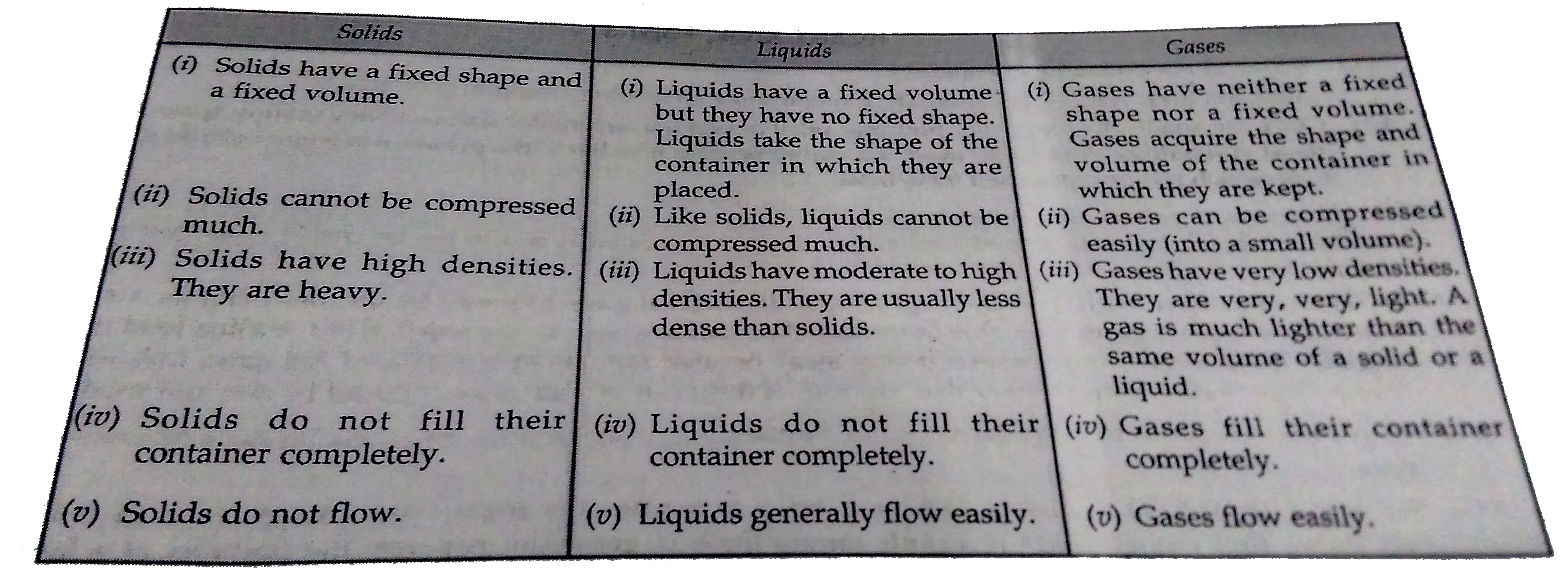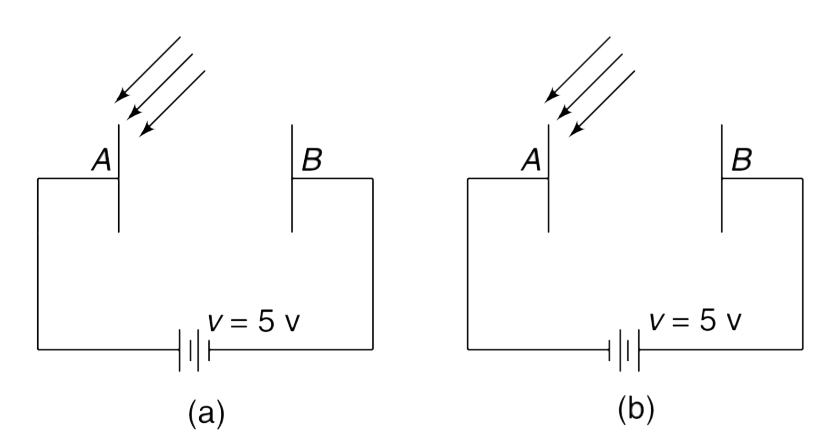(a) Tabulate the differences in the characteristics of states of matter.
(b) Comment upon the following: rigidity. Compressibility. Fluidity. Filling a gas container, shape, kinetic energy and density.
(a) The main differences in the characteristics of the three states of matter, solids, liquids and gases are given below :

(b) (i) Rigidity. Rigidity refers to the property of a solid to resist change in its shape (or resist deformation) when an outside force is applied. In most simple terms, rigidity means 'stiffness'. The particles in a solid are very closely packed and there are very strong forces of attraction between them, so solids posses high rigidity. Liquids and gases are not rigid because the positions of their particles are not fixed.
(ii) Compressibility. Compressibility is the property of a fluid (or a solid) due to which its volume decreases when pressure is applied. The particles in gases have large spaces between them due to which their volume decrease too much when pressure is applied on them. So, gases have high compressibility. On the other hand , the particles in solids and liquids are closely packed, so solids and liquids do not have much compressibility.
(iii) Fluidity. The property of flowing easily is called fluidity. Gases and liquids exhibit the property of fluidity, so they are called fluids. Due to large interparticles distance and very weak forces of attraction, gases can flow extremely easily. So, the gases have very high fluidity. And because of comparatively smaller interparticle distances and stronger forces of attraction between their particles, the fluidity of liquids is less than that of gases. Solids are not fluids, they have no fluidity.
(iv) Filling a gas container. A gas fills its container completely because due to high kinetic energy and negligible interparticles forces of attraction, the particles in a gas move with high speeds in all directions and occupy all the space in the container.
(v) Shape. The external form or appearance of a substance is called its shape. A solid has a fixed shape because the particles in a solid are closely packed and their positions are fixed due to strong forces of attraction between them. The liquids and gases do not have fixed shapes because the positions of particles in them are not fixed due to comparatively weaker forces of attraction between them.
(vi) Kinetic energy. The energy possessed by a material due to the motion of its particles is called kinetic energy. At a given temperature, the particles in a gas have the maximum kinetic energy because they move with high speeds due to weakest forces of attraction among them. Liquids have lesser kinetic energy (than gases) whereas solids have the the least kinetic energy at a given temperature.
(vii) Density. The mass per unit volume of a material is called its density. Solids have high densities because their particles are very close together. Liquids have usually lower densities than solids because their particles are somewhat more loosely packed than that in solids. Gases have the lowest densities because their particles are very far apart from one another.
Related Playlists
- BOOK - LAKHMIR SINGH & MANJIT KAURCHAPTER - MATTER IN OUR SURROUNDINGS EXERCISE - HOTS5videos
MATTER IN OUR SURROUNDINGS
- BOOK - LAKHMIR SINGH & MANJIT KAURCHAPTER - IS MATTER AROUND US PURE EXERCISE - NCERT BOOK PAGE 241videos
IS MATTER AROUND US PURE
- BOOK - LAKHMIR SINGH & MANJIT KAURCHAPTER - MODEL TEST PAPER 1EXERCISE - SECTION B3videos
MODEL TEST PAPER 1
Similar Practice Problems
- Question 1 - Select One
Matter around us can exist in three different states , namely , solids , liquid and gas . The correct order of their compressibility is
ALiquid < Gas < SolidBSolid < Liquid < GasCGas < Liquid < SolidDSolid < Gas < Liquid - Question 1 - Select One
An unknown gas is placed in a sealed container with a fixed volume. Which of the characteristics listed change(s) when the container is heated from 25∘C to 250∘C?
(P) The density of the gas
(Q) The average kinetic energy of the molecules
(R) The mean free path between molecular collisions
(R) The mean free path between molecular collisionsAP onlyBQ onlyCR onlyDP and Q only - Question 1 - Select One
A fixed container is fitted with a piston which is attached to a spring of spring constant k. The other and of the spring is attached to a rigid wall. Initially the spring is in its natural length and the length of container between the piston and its side wall is L. Now an dideal diatomic gas is slowly filled in the container so that the piston moves quasistatically. It pushed the piston by x so that the spring now is compressed by x. The total rotaional kinetic energy of the gas molecules in terms of the displacement x of the piston is (there is vacuum outside the container)
 AkxLB4kxLCkx(x+L)D2kx2L
AkxLB4kxLCkx(x+L)D2kx2L
Similar Questions
(a) Tabulate the differences in the characteristics of states of matter.
(b) Comment upon the following: rigidity. Compressibility. Fluidity. Filling a gas container, shape, kinetic energy and density.View SolutionTabulate the differences in the states of matter on the basis of the following characteristics :
(i) Rigidity (ii) Kinetic energy (iii) Density.View SolutionState if each of the following statements is true or false. Give reasons for your answer.
a) In an elastic collision of two bodies, the momentum and energy of each body is conserved.
b)Total energy of a systm is always conserved,no matter what internal and external forces on the body are present.
Work done in the motion of a body over a closed loop is zero for every force in nature.
d) In an inelastic collision, the final kinetic energy is always less than the initial kinetic energy of the sytem.View SolutionState if each of the following statements is true or false. Give reasons for your answer.
a) In an elastic collision of two bodies, the momentum and energy of each body is conserved.
b)Total energy of a systm is always conserved,no matter what internal and external forces on the body are present.
Work done in the motion of a body over a closed loop is zero for every force in nature.
d) In an inelastic collision, the final kinetic energy is always less than the initial kinetic energy of the sytem.View SolutionIn a photoelectric experiment, a monochromatic light is incident on the metal plate A. It was observed that with V=5volt, the maximum kinetic energy of photoelectrons striking plate B was 1eV. The polarity of the applied potential difference was as shown in figure (a). With polarity of the applied potential difference reversed (as shown in figure (b)) and frequency of incident light doubled, it was observed that in saturation state, the kinetic energy of electrons striking plate B ranged between 5 eV to 20 eV. Find the work function of metal used in plate A.
 View Solution
View SolutionA parallel plate air filled capacitor having area 40cm2 and plate spacing 1.0 mm is charged to a potential difference of 500V. Find (a) the capacitance, (b) the magnitude of the charge on each plate ( c) the stored energy, (d) the electric field between the plates and (e ) the energy density between the plates.
View Solution(a) What is the reason for the existence of the three states of matter ?
(b) What will happen when solid ammonium chloride is heated ?
(c ) The room temperature is 25∘C. What is the corresponding temperature on the Kelvin scale ?
(d) What happens to the particle motion if the temperature of the gas is increased ?
(e ) A substance 'X' was highly compressible and could be easily liquified. It could also take up the shape of any container. Predict the nature of the substance. Enlist four properties of this state of matter.View Solution

